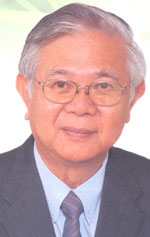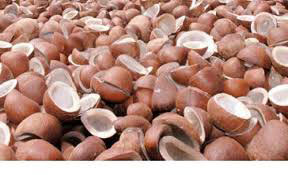EVERYONE knows about ‘THE COCONUT TREE’, but how many know about its vast productive use?
It can easily be called ‘the tree of life’ as it provides food and water, and serves the needs of man in terms of nutrition, shelter and medicine.
In Guyana, the coconut three can be found in almost every yard in every rural village, and on some residences in the capital city, Georgetown.
Standing both short and tall, upright and sloped, the coconut tree does not only beautify its surroundings, but provides a ready source of refreshment after a good game of cricket or football, or a march in the brilliant tropical sun, or a fishing trip in one of the many backdams in 83,000 square miles of Guyana.

It is estimated that some 60,000 acres of land are under coconut cultivation; and in terms of priority agriculture crop, coconut ranks third behind rice and sugar.
About half of the coconuts produced are exported to The Dominican Republic at a good price. These are mainly dried nuts.
Seasoned private and public sector manager and professional nutritionist Dr Leslie Chin said years ago that the coconut contributed one per cent of Guyana’s Gross Domestic Product (GDP). Given its priority ranking, the contribution of the produce to GDP can easily be considered an underachievement.
But the Ministry of Agriculture, through the National Agriculture Research and Extension Institute (NAREI), has signalled its intention to resuscitate and position the industry on the path to realise its full potential.
WORK STARTED
This will require much work, Dr Chin told the Chronicle. He noted that, importantly, the work has started.
Recently, two experts from Mexico visited Guyana to host a workshop for local farmers and related players in the coconut industry. During discussions, the experts focused on a range of areas, including value-added; pest control; developing plant varieties; and good husbandry practices.

Dr Chin said the way forward for this industry is placing focus on the value-added side of production, but the industry has to be private sector-driven, with Government providing the enabling environment.
The Government, he said, has shown a genuine interest in resuscitating the industry, but for the industry to reach the stage it should be, it would require receiving similar support as is given to rice and sugar.
“My gut feeling is that we can double our productivity just by recognising the potential of the industry. By recognising that fact, we can quadruple the opportunities to be had from value-added products,” Dr Chin said.
HIGH DEMAND
From the tree can come a product that is ideal for practically anything. Once the tree is about 30 years old, the trunk can be used to make durable wood craft; and many here use the branches to make brooms. From the coconut tree comes copra and coconut water.
According to Dr Chin, there currently exists a ready market for coconut water, demand for the product grows by some 5 to 10 per cent annually; but market for the copra is limited, stifling its potential.
He explained that it is much cheaper to produce palm or soya bean oil than it is to produce coconut oil.

Dr Chin told this publication that, some time ago, the fibre from coconut was used to make mattresses; and with new technology and the addition of balata, a more refined product has been made. These mattresses, the scientist said, were produced on a small scale under a poverty reduction programme in the Pomeroon, Region Two (Pomeroon-Supenaam).
Dr Chin, a chemist by profession, spearheaded the making of the mattresses, and sold more than 200 to the Guyana Defence Force (GDF). He said there is a demand for the product, but it needs to be properly marketed.
The dust from the coconut fibre can also be used as fertiliser, while the shell of the coconut has been identified as a valuable product of the nut. Apart from being used to make craft items, the shell is also used to make charcoal.
ACTIVATED CARBON
The charcoal, Dr Chin said, can be converted into activated carbon, which has a market in Guyana; but it will call for strategic business partnerships.
He said that in the heydays of OMAI, the company had a demand for some 800 tonnes of activated carbon annually at US$800 per tonne.
Activated carbon is used in the extraction of gold, and the scientist said that although Guyana had the capacity of supplying OMAI’s demand, transportation was an issue.
He estimated at the time that the production of 800 tonnes of activated carbon required some 50 million coconut shells, which was gettable as Guyana was producing some 100 million nuts on an annual basis.
With several large mining operations in Guyana using cyanide in the gold extraction process, Dr Chin said there is a viable opportunity for locals to supply activated carbon to these companies, but the business will require a partnership approach to be successful.
There can also be a healthy market for toddy. Toddy is a sweet drink extracted from the inflorescent before it is opened.
The liquid is extracted by tying the inflorescent before it opens, putting it in a downward direction and cutting the tip of the stock. A container is placed to collect the sweet substance, which amounts to about 2 litres per day, and the inflorescent pours for 20 days. The tasty drink does not require processing, but requires refrigeration to remain fresh.
Dr Chin said if farmers are cultivating coconut palms for toddy, they can plant the trees close together, and a hectare of crop can produce 250 tonnes of litres. At US$2 per litre, he said, a farmer can earn a cool US$500,000.
SUGAR
The liquid, Dr Chin said, can also be evaporated to produce syrup, which, when converted in a concentrate, can produce crystallised sugar, much like the crystallised sugar from sugar cane.
The market potential of this product, he said, is great, but requires marketing to be successful commercially.
Coconut is also being used to make pastries and cosmetics. It can also be used to make bio-diesel, Dr Chin said. However, it would not be a viable business as oil from palm can be produced way cheaper.
A yellow colouring can also be extracted from the root of the tree, which can be used for dying fabrics. But this aside, the coconut milk and oil have been promoted as products with great health benefits.
Dr Chin believes that in the next 20 years, if given proper attention, the coconut industry, coconut production and production of coconut products can become a major contributor to GDP.
In another decade, he said, about 90 per cent of nuts produced will be for the water, as the demand for coconut water has been increasing significantly every year.
Importantly too, he said, like the other value-added products from coconut, production has to expand from the cottage industry to the commercial level to gain mainstream recognition.
But the industry, he said, is not big enough for this to happen. Another disadvantage, Dr Chin said, is that many coconut cultivations are small and not centralised, thus not allowing for harnessing of maximum benefits in relation to the logistical side of business.
These issues, he said can be fully addressed with the establishment of a team of experts to look into the challenges facing the industry, and providing a plan for the way forward.
But importantly, he said, it would be necessary for Government to give its full support to this work and a strong commitment to development of the coconut industry.
Government has recognised the potential of the industry in its National Agriculture Strategy 2013-2020. In the strategy paper, the Government said the coconut industry will be re-engineered with a new orientation for value-added products.
Globally, the coconut industry is estimated to worth US$1 billion, and this value is likely to continue growing in the years ahead.
Dr Chin said that if the industry is given its due attention, there will be a bright future ahead for the industry.
By Tajeram Mohabir



.jpg)








